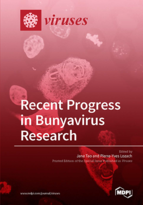Recent Progress in Bunyavirus Research
A special issue of Viruses (ISSN 1999-4915). This special issue belongs to the section "Animal Viruses".
Deadline for manuscript submissions: closed (29 February 2016) | Viewed by 113413
Special Issue Editors
Interests: amyloids; arbovirus; cell biology of virus entry; viral virulence factors
Special Issues, Collections and Topics in MDPI journals
Interests: RNA viruses, structure and function, assembly, viral RNA replication and transcription
Special Issues, Collections and Topics in MDPI journals
Special Issue Information
Dear Colleagues,
The Bunyaviridae is the largest family of RNA viruses, with over 350 isolates worldwide distributed into five genera (i.e. Hantavirus, Orthobunyavirus, Nairovirus, Tospovirus, and Phlebovirus). Many of these viruses are significant human or agricultural pathogens. The increasing number of reports on new emerging bunyaviruses and infection episodes makes it essential that we obtain a comprehensive understanding of bunyaviruses and their infection mechanisms. Although all bunyaviruses possesses a tripartite, negative-sense (or ambi-sense) RNA genome, they exhibit substantial differences in their structure, genome organization and replication strategies, which make functional interpolation across genus boundaries difficult.
Fortunately, the bunyavirus field has witnessed many exciting new findings and breakthroughs in recent years. These discoveries span a wide spectrum of research areas, including structural characterization of viruses and viral proteins, the identification of new viruses, investigations into host switch and vectors of transmission, genome-based analysis of virus evolution and phylogenetic lineages, the development of new research tools such as replicons and reverse genetics, molecular characterization of the virus life cycle at the cell level (i.e. cell entry, replication, transcription, translation, genome packaging, reassortment, and virus assembly, etc.), studies of virus-host interactions and host antiviral defense, the development of vaccines/drugs and the use of bunyaviruses for novel applications.
In this special of Viruses, we would like to include both research and review papers that altogether can provide a glimpse into the latest research on bunyaviruses and at the same time highlight some of the important research achievements made in recent years. Study topics of both fundamental and applied nature are welcome. In doing so, we hope to gain an informed perspective of future research directions and also stimulate research in some of the understudied areas.
Dr. Jane Tao
Dr. Pierre-Yves Lozach
Guest Editors
Please find more related articles on this topic:
- RNA Encapsidation and Packaging in the Phleboviruses, by Hornak, K. et al.
- Viral RNA Silencing Suppression: The Enigma of Bunyavirus NSs Proteins, by Hedil M. and Kormelink R.
Manuscript Submission Information
Manuscripts should be submitted online at www.mdpi.com by registering and logging in to this website. Once you are registered, click here to go to the submission form. Manuscripts can be submitted until the deadline. All submissions that pass pre-check are peer-reviewed. Accepted papers will be published continuously in the journal (as soon as accepted) and will be listed together on the special issue website. Research articles, review articles as well as short communications are invited. For planned papers, a title and short abstract (about 100 words) can be sent to the Editorial Office for announcement on this website.
Submitted manuscripts should not have been published previously, nor be under consideration for publication elsewhere (except conference proceedings papers). All manuscripts are thoroughly refereed through a single-blind peer-review process. A guide for authors and other relevant information for submission of manuscripts is available on the Instructions for Authors page. Viruses is an international peer-reviewed open access monthly journal published by MDPI.
Please visit the Instructions for Authors page before submitting a manuscript. The Article Processing Charge (APC) for publication in this open access journal is 2600 CHF (Swiss Francs). Submitted papers should be well formatted and use good English. Authors may use MDPI's English editing service prior to publication or during author revisions.
Keywords
- Bunyaviridae
- Orthobunyavirus
- Hantavirus
- Phlebovirus
- Nairovirus
- Tospovirus
- Emerging diseases
- Vectors and transmission
- Virus-host interactions
- Bunyavirus entry
- Bunyavirus replication
- Bunyavirus assembly and release
- Viral immunity
- Reverse genetics
- Vaccine development
- Antiviral therapeutics








